Nucleophilic attack Study guides, Class notes & Summaries
Looking for the best study guides, study notes and summaries about Nucleophilic attack? On this page you'll find 86 study documents about Nucleophilic attack.
Page 3 out of 86 results
Sort by

-
13.3 Elimination Reactions in Halogenoalkanes Review Exam Guide 2024.
- Exam (elaborations) • 5 pages • 2024
-
Available in package deal
-
- $9.79
- + learn more
13.3 Elimination Reactions in Halogenoalkanes Review Exam Guide 2024. How do halogenoalkanes typically react? - correct answer By nucleophilic substitution How do halogenoalkanes react under different conditions? - correct answer By elimination How does elimination reactions occur? - correct answer A hydrogen halide is eliminated from the molecule, leaving a double bond in its place so that an alkene is formed What is the OH- ion from aqueous sodium or potassium hydroxide? - correct an...
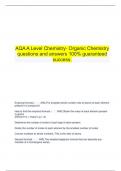
-
AQA A Level Chemistry- Organic Chemistry questions and answers 100% guaranteed success.
- Exam (elaborations) • 14 pages • 2024
-
- $13.49
- + learn more
AQA A Level Chemistry- Organic Chemistry questions and answers 100% guaranteed success. Empirical formula - ANS.The simplest whole number ratio of atoms of each element present in a compound How to find the empirical formula - ANS.Obtain the mass of each element present in grams (Element % = mass in g = m) Determine the number of moles of each type of atom present Divide the number of moles of each element by the smallest number of moles Co...
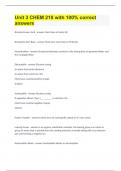
-
Unit 3 :CHEM 210 with 100% correct answers
- Exam (elaborations) • 4 pages • 2023
-
Available in package deal
-
- $13.99
- + learn more
Bronsted-Lowry Acid Must Have a Proton (H) Bronsted-Lowry Base Must have Lone Pairs or Pi Bonds Neutralization Strong Acid donates a proton to the Strong Base to generate Water and the Conjugate Base Electrophile Electron Loving An atom that wants electrons. An atom that is electron rich. Must have a partial positive charge. (Cation) Nucleophile Nucleus Loving If opposites attract, then a _________ is electron rich. Must have a partial negative charge. (An...
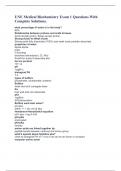
-
UNE Medical Biochemistry Exam 1 Questions With Complete Solutions.
- Exam (elaborations) • 8 pages • 2024
-
- $11.49
- + learn more
UNE Medical Biochemistry Exam 1 Questions With Complete Solutions. what percentage of water is in the body? 60% Relationship between protons and acids & bases Acids donate proton. Bases accept proton Strong Acids Vs Weak Acids Strong acids fully dissociate (100%) and weak acids partially dissociate properties of water dipole dipole polar H bonding dissolves electrolytes ( CL /Na) Small Kd- doesn't dissociate alot kw ion product 10^-14 pH -log[H+] biological PH 7.4 types of ...

-
CHM 242 EXAM 1 || Questions and 100% Accurate Answers.
- Exam (elaborations) • 5 pages • 2024
-
- $10.09
- + learn more
Cumulated Diene correct answers double bonds are adjacent Conjugated Diene correct answers double bonds separated by 1 single bond Isolated Diene correct answers double bonds separated by more than 1 single bond Heteroatoms correct answers may be involved in conjugated dienes atom that isn't a carbon atom Diene Formation correct answers elimination using a strong, bulky base t-BuOK Single Bonds in Conjugated Diene correct answers shorter than typical will freely rotate allows...
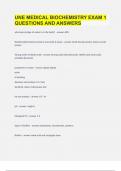
-
UNE MEDICAL BIOCHEMISTRY EXAM 1 QUESTIONS AND ANSWERS.
- Exam (elaborations) • 13 pages • 2023
-
Available in package deal
-
- $14.99
- + learn more
what percentage of water is in the body? 60% Relationship between protons and acids & bases Acids donate proton. Bases accept proton Strong Acids Vs Weak Acids Strong acids fully dissociate (100%) and weak acids partially dissociate properties of water dipole dipole polar H bonding dissolves electrolytes ( CL /Na) Small Kd- doesn't dissociate alot kw ion product 10^-14 pH -log[H+] biological PH 7.4 types of buffers phosphates, bicarbo...

-
Chapter 18 EAS Questions and Answers 100% correct
- Exam (elaborations) • 9 pages • 2023
-
Available in package deal
-
- $12.99
- + learn more
Chapter 18 EAS Questions and Answers 100% correct Electrophilic Aromatic Substitution -reaction in which an electrophile is substituted for a hydrogen on an aromatic ring -many different types of EAS reactions based on what functional group replaces the hydrogen Alkene vs Benzene Alkenes undergo addition reactions but Benzenes react differently under similar reagents. Don't confuse the two, one is Aromatic and the other isn't. Aromatic Requirements The organic structure must...
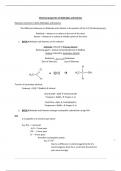
-
Chemical properties of Aldehydes and Ketones
- Exam (elaborations) • 45 pages • 2024
-
- $12.49
- + learn more
Chemical properties of Aldehydes and Ketones Reactions common to both Aldehydes and Ketones The difference between an Aldehyde and a Ketone is the position of the C=O (Carbonyl group). Aldehyde – always on a carbon at the end of the chain Ketone – Always on a carbon at middle carbon of the chain 1. BOTH Aldehydes and Ketones can be reduced Aldehyde reduced to Primary Alcohol Reducing agent = Sodium tetrahydroborate III (NaBH4) Ketone reduced to Secondary Alcohol Reduction Oxidisatio...
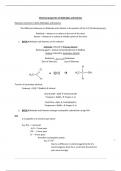
-
Chemical properties of Aldehydes and Ketones
- Exam (elaborations) • 45 pages • 2024
-
- $10.99
- + learn more
Chemical properties of Aldehydes and Ketones Reactions common to both Aldehydes and Ketones The difference between an Aldehyde and a Ketone is the position of the C=O (Carbonyl group). Aldehyde – always on a carbon at the end of the chain Ketone – Always on a carbon at middle carbon of the chain 1. BOTH Aldehydes and Ketones can be reduced Aldehyde reduced to Primary Alcohol Reducing agent = Sodium tetrahydroborate III (NaBH4) Ketone reduced to Secondary Alcohol Reduction Oxidisation ...
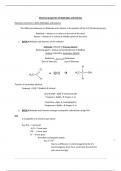
-
Chemical properties of Aldehydes and Ketones
- Exam (elaborations) • 45 pages • 2024
-
- $17.99
- + learn more
Chemical properties of Aldehydes and Ketones Reactions common to both Aldehydes and Ketones The difference between an Aldehyde and a Ketone is the position of the C=O (Carbonyl group). Aldehyde – always on a carbon at the end of the chain Ketone – Always on a carbon at middle carbon of the chain 1. BOTH Aldehydes and Ketones can be reduced Aldehyde reduced to Primary Alcohol Reducing agent = Sodium tetrahydroborate III (NaBH4) Ketone reduced to Secondary Alcohol Reduction Oxidisatio...

How did he do that? By selling his study resources on Stuvia. Try it yourself! Discover all about earning on Stuvia


